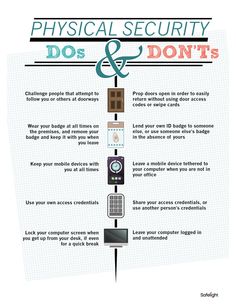
What is the difference between physical security and electronic security
Security plays a crucial role in every aspect of our lives, whether at home, in the workplace, or in public spaces. When it comes to safeguarding our assets, it is essential to understand the difference between physical security and electronic security. While both focus on protecting against threats and vulnerabilities, there are distinct variations between these two approaches.
Physical security refers to the measures and strategies put in place to prevent unauthorized access to physical spaces, installations, and assets. This can include physical barriers like fences, gates, locks, and access control systems. It also encompasses security personnel, such as guards and surveillance cameras, that monitor and protect the premises. Physical security aims to deter and detect any potential breaches and ensure the safety of people and physical property.
Electronic security, on the other hand, focuses on safeguarding digital assets and protecting data and information from unauthorized access, theft, or damage. This involves the use of technologies like firewalls, encryption, password management systems, and intrusion detection systems. Electronic security is concerned with securing networks, computers, servers, and electronic devices to prevent cyberattacks, data breaches, and other digital threats.
While physical security primarily deals with securing the physical environment, electronic security focuses on protecting the digital realm. However, it is important to note that these two types of security are not mutually exclusive. In fact, they often complement each other to provide a comprehensive security framework. By understanding the difference between physical and electronic security, organizations and individuals can implement appropriate measures to mitigate risks and ensure the overall security of their assets.
“The key to effective security lies in finding the right balance between physical security measures and electronic security solutions.”
The Importance of Physical Security
Physical security is a crucial aspect of overall security. While electronic security measures are important for protecting digital assets, physical security is designed to protect tangible assets, such as people, property, and physical resources, from unauthorized access or harm.
One of the main reasons why physical security is important is because it serves as a deterrent against potential intruders. Visible security measures, such as fences, locks, and security guards, can discourage criminals from attempting to gain unauthorized access to a facility or property.
Physical security also helps in preventing theft and vandalism. By implementing locks, alarms, surveillance cameras, and other security devices, organizations can decrease the likelihood of theft and damage to their property.
Additionally, physical security is essential for ensuring the safety and well-being of individuals. It helps create a secure environment where employees, residents, and visitors feel safe. This can enhance productivity, morale, and overall quality of life within a facility.
Another benefit of physical security is its ability to control access. By implementing access control systems, organizations can restrict entry to specific areas and allow only authorized personnel to access sensitive information or valuable assets. Access control measures can include key cards, biometric scanners, or security personnel at entry points.
In conclusion, physical security plays a vital role in protecting people, property, and tangible resources. While electronic security is important for safeguarding digital assets, physical security is what provides the foundation for overall security. It is imperative for organizations and individuals to understand the distinction between physical security and electronic security and to prioritize the implementation of appropriate physical security measures.
The Role of Electronic Security
Understanding the difference between physical security and electronic security is crucial in today’s world. While physical security focuses on protecting a physical space and its assets, electronic security is all about safeguarding digital information and systems.
Electronic security plays a vital role in maintaining the confidentiality, integrity, and availability of electronic resources. It includes various measures such as encryption, access control systems, firewalls, intrusion detection systems, and video surveillance.
One of the main functions of electronic security is to prevent unauthorized access to sensitive information. Encryption is used to convert data into a format that can only be understood by authorized parties. Access control systems ensure that only authorized individuals can enter certain areas or access specific resources.
Another important aspect of electronic security is protecting against cyber threats. Firewalls and intrusion detection systems are used to monitor network traffic, detect malicious activities, and prevent unauthorized access to computer systems and networks. These measures help prevent data breaches, malware infections, and other cyber-attacks.
Furthermore, electronic security also plays a role in physical security. Video surveillance systems, for example, utilize electronic components to monitor and record activities in a physical space. These systems can provide evidence in the event of a security incident and act as a deterrent against potential threats.
In conclusion, electronic security complements physical security by providing additional layers of protection for digital resources and information. It helps safeguard against cyber threats, prevent unauthorized access to sensitive information, and enhance overall security measures.
An Overview of Physical Security
Physical security is a crucial aspect of overall security measures. It involves the protection of people, equipment, and resources from physical threats such as theft, vandalism, and unauthorized access. Physical security focuses on implementing deterrent measures to prevent intrusions and ensure the safety and integrity of physical infrastructure.
The main difference between physical security and electronic security lies in the nature of the threats they address. While electronic security is designed to protect data and information stored electronically, physical security ensures the physical protection of assets, facilities, and individuals.
Physical security measures include the use of access control systems, surveillance cameras, alarms, locks, and security personnel. These measures are intended to monitor and control access to sensitive areas, detect and deter unauthorized activities, and respond to incidents promptly and effectively.
What sets physical security apart is its tangible presence. It includes physical barriers, environmental controls, and other physical measures that can be seen, touched, and experienced. These measures can be adjusted according to the assessed risks and security needs of an organization.
Physical security is an integral component of a comprehensive security strategy. It complements electronic security measures by providing an additional layer of protection against physical threats. By implementing robust physical security measures, organizations can mitigate risks and safeguard their assets, people, and operations.
The Components of Electronic Security
Electronic security refers to the use of technology to protect people, property, and information. Although there are similarities between physical security and electronic security, there are also key differences that set them apart.
Physical security focuses on securing physical assets, such as buildings, entrances, and exits. It involves measures like locks, alarms, and surveillance cameras to prevent unauthorized access and detect intruders. Physical security is typically more visible and tangible, with a direct physical presence.
Electronic security, on the other hand, deals with securing digital assets and information. It encompasses various components that work together to provide a comprehensive security system. These components include:
- Access control systems: These systems enable the management and restriction of access to specific areas or information. They can involve technologies like key cards, biometric scanners, or passwords.
- Video surveillance: Video cameras and monitoring systems are used to observe and record activities in specific areas, providing evidence in case of incidents.
- Intrusion detection systems: These systems detect unauthorized entry or activities within a protected area through sensors, alarms, or motion detectors.
- Network security: This component focuses on protecting computer networks and information systems from unauthorized access, data breaches, and other cyber threats.
- Fire and smoke detection: Sensors, alarms, and sprinkler systems are employed to detect and respond to fires and smoke, preventing potential damage.
- Alarm systems: These systems signal the occurrence of a security breach, triggering alerts and notifications to designated authorities or personnel.
In summary, the main difference between physical security and electronic security lies in the assets they secure and the methods they employ. While physical security safeguards tangible assets, electronic security protects digital assets and information. Both types of security have their own essential components, which work together to create a comprehensive security system.
The Advantages of Physical Security
In understanding the distinction between physical security and electronic security, it is important to recognize what each term refers to and the difference between them.
Physical security is the protection of physical assets, such as buildings, equipment, and people, from unauthorized access, damage, or theft. It involves the use of physical barriers, locks, alarms, and security personnel to prevent or deter potential threats.
One of the main advantages of physical security is its tangible nature. Physical security measures can be seen, felt, and touched, providing a sense of reassurance and deterrent to potential intruders. This visual presence can serve as a deterrent in itself, making it less likely for criminals or unauthorized individuals to target a facility.
Additionally, physical security is often more reliable and less prone to technological glitches or vulnerabilities compared to electronic security systems. While electronic security systems can be prone to hacking, malfunctions, or power outages, physical security measures are generally more resilient and can continue to provide protection even in the event of technical failures.
Moreover, physical security measures can also be more cost-effective in some cases. While electronic security systems may require significant upfront costs for equipment installation and maintenance, physical security measures such as fences, gates, and access control systems can provide long-term protection at a lower cost.
Ultimately, physical security plays a crucial role in safeguarding assets, deterring potential threats, and instilling a sense of security in individuals. It complements electronic security systems, working together to provide layered protection against both physical and technological risks.
The Benefits of Electronic Security
Electronic security is a modern and sophisticated approach to ensuring safety and protection. Unlike physical security, which relies on manual intervention and human presence, electronic security utilizes technology and automation to enhance the level of security.
One of the main advantages of electronic security is its efficiency. Electronic security systems can monitor and protect large areas and multiple points simultaneously, without the need for constant physical presence. This makes it an ideal choice for organizations with vast physical spaces to secure, such as warehouses, airports, or shopping malls.
Another benefit of electronic security is its reliability. Technology such as surveillance cameras, access control systems, and alarm systems can operate 24/7, providing continuous monitoring and immediate response to any threats. They are not affected by factors such as fatigue, human error, or distraction, ensuring a higher level of security.
Furthermore, electronic security offers convenience and flexibility. Systems can be customized and tailored to meet specific security needs, allowing for the implementation of advanced features such as facial recognition, biometric access control, or remote monitoring. These features provide enhanced security measures and make it easier to manage access, detect potential risks, and respond to emergencies.
Finally, electronic security offers scalability and cost-effectiveness. As technology advances, it becomes easier to upgrade and expand existing security systems without significant disruptions or expenses. This means that organizations can adapt their security measures to meet changing needs and requirements without incurring substantial costs.
| Benefits of Electronic Security |
| Efficiency |
| Reliability |
| Convenience and flexibility |
| Scalability and cost-effectiveness |
In conclusion, electronic security is a valuable asset for organizations looking to enhance their security measures. It offers efficiency, reliability, convenience, scalability, and cost-effectiveness. By leveraging technology and automation, electronic security provides a comprehensive and advanced approach to safeguarding physical spaces and assets.
Common Misconceptions about Physical Security
There are often misconceptions about the difference between physical security and electronic security. Many people mistakenly believe that physical security is only about guarding physical assets, while electronic security deals with the protection of data and information. However, this is a misunderstanding. Physical security is not limited to just guarding physical assets and buildings; it also includes measures to protect against unauthorized access, theft, and vandalism.
One of the common misconceptions is that physical security is not as important as electronic security. Some may think that since electronic security deals with data and information, it is more crucial to invest in electronic security systems. However, physical security plays a crucial role in ensuring the overall security of an organization. It provides the first line of defense against intruders and unauthorized access, which can lead to data breaches and other security incidents.
Another misconception is that physical security is a one-time investment. Some may believe that once physical security measures are in place, there is no need for further investment or updates. However, physical security requires regular assessment and updates to adapt to changing threats and vulnerabilities. Technology and tactics used by criminals are constantly evolving, and physical security measures must be updated accordingly to remain effective.
Furthermore, there is a misconception that physical security and electronic security are mutually exclusive. Some may believe that organizations must choose between physical security measures or electronic security systems. However, the reality is that both types of security are complementary and should be integrated to provide comprehensive protection. Physical security measures, such as access control systems and surveillance cameras, can work together with electronic security systems, such as firewalls and intrusion detection systems, to create a robust security framework.
In conclusion, there are several common misconceptions about physical security. It is important to understand that physical security is not just about guarding physical assets, but also about protecting against unauthorized access and other physical threats. Physical security is equally important as electronic security and requires regular updates and integration with electronic security systems for comprehensive protection.
Common Misconceptions about Electronic Security
Understanding the difference between physical security and electronic security is crucial for protecting businesses and individuals from potential threats. Unfortunately, there are many common misconceptions about electronic security that can lead to misunderstandings and vulnerabilities. Let’s debunk some of these misconceptions:
- Electronic security is the same as physical security: One of the most common misconceptions is that electronic security is just an extension of physical security. This is not true. While physical security focuses on protecting people and property through measures such as locks and surveillance cameras, electronic security deals with protecting digital data and systems from unauthorized access and manipulation.
- Electronic security is only necessary for large organizations: Another misconception is that electronic security is only essential for big corporations. In reality, any business, regardless of size, can be a target for cyber attacks. Small businesses and individuals also need to invest in electronic security measures to protect themselves from potential threats.
- Antivirus software is enough for electronic security: While antivirus software is an essential component of electronic security, it is not sufficient on its own. It is important to understand that cyber threats are constantly evolving, and relying solely on antivirus software can leave you vulnerable. A comprehensive electronic security strategy should include multiple layers of protection, such as firewalls, intrusion detection systems, and regular security updates.
- Electronic security is only about protecting against external threats: Many people mistakenly believe that electronic security is only concerned with external threats, such as hackers. However, internal threats can be just as damaging. Insider threats, such as disgruntled employees or accidental data breaches, can pose significant risks to an organization’s electronic security. It is crucial to implement measures to mitigate both external and internal threats.
- Electronic security is a one-time investment: Some individuals mistakenly believe that once they have implemented electronic security measures, they are permanently protected. However, electronic security is an ongoing process. Cybersecurity requires constant monitoring, regular software updates, and employee training to stay ahead of evolving threats. It is important to understand that cybercriminals are continuously finding new ways to exploit vulnerabilities and that electronic security measures need to be regularly updated and improved to remain effective.
By debunking these common misconceptions, individuals and businesses can gain a better understanding of electronic security and make informed decisions to protect themselves from potential threats.
The Challenges in Implementing Physical Security
Physical security involves the protection of physical assets, people, and property from unauthorized access, damage, or theft. Implementing physical security measures can be a challenging task. It requires careful planning, coordination, and a comprehensive understanding of the potential risks and vulnerabilities.
One of the main challenges in implementing physical security is the ever-evolving nature of threats. Criminals are constantly finding new ways to breach security measures, and organizations must adapt and stay ahead to ensure the safety of their assets. This requires regularly updating and upgrading security systems and protocols.
Another challenge is the cost associated with implementing physical security measures. Installing surveillance cameras, alarm systems, access control systems, and other physical security technology can be expensive. Organizations must allocate the necessary funds to purchase and maintain these systems to effectively protect their assets.
Additionally, physical security measures can sometimes be inconvenient for employees or other authorized individuals. For example, implementing strict access control measures may require additional time for employees to enter secure areas, which can affect productivity. Finding the right balance between security and convenience is crucial but can be a challenge.
Moreover, the effectiveness of physical security measures heavily relies on human factors. Ensuring that security guards and personnel are properly trained, vigilant, and follow protocols consistently is essential. The overall success of physical security largely depends on the people responsible for its implementation and operation.
In conclusion, implementing physical security poses various challenges that organizations must address. By staying current with the latest security technologies, adequately allocating resources, balancing convenience and security, and prioritizing proper training and procedures, organizations can improve the effectiveness of their physical security and protect their assets.
The Challenges in Implementing Electronic Security
Implementing electronic security can present several challenges. One of the main challenges is understanding the difference between physical and electronic security. While physical security focuses on protecting assets through barriers and physical measures, electronic security involves safeguarding data and information through technology.
One challenge in implementing electronic security is determining what kind of security measures are needed for a particular organization or system. This requires a thorough understanding of the potential risks and vulnerabilities that the system may face. Without this understanding, it can be difficult to determine which electronic security measures will be most effective.
Another challenge is keeping up with evolving technology. As the digital landscape continues to change at a rapid pace, so do the methods and tools used by cyber criminals. Implementing effective electronic security requires staying up to date with the latest advancements and adapting security measures accordingly.
Additionally, there is the challenge of balancing convenience with security. Electronic security measures, such as strong passwords and multi-factor authentication, can often be seen as inconvenient by users. Finding a balance between ensuring the security of the system and maintaining usability can be a difficult task.
Lastly, there is the challenge of cost. Implementing robust electronic security measures can require a significant financial investment. This can be a barrier for smaller organizations or businesses with limited budgets. Finding cost-effective solutions while still maintaining adequate security can be a challenge.
In conclusion, implementing electronic security comes with several challenges, including understanding the difference between physical and electronic security, determining the necessary security measures, keeping up with evolving technology, balancing convenience and security, and managing costs. Overcoming these challenges is essential for organizations to effectively protect their digital assets and information.
Integration of Physical and Electronic Security Systems
One important aspect of the distinction between physical security and electronic security is the integration of these two systems. Physical security is focused on protecting the physical assets of a facility, such as buildings, equipment, and personnel, while electronic security involves the use of electronic devices and systems to monitor and control access to these assets.
The integration of physical and electronic security systems is crucial for an effective overall security strategy. By combining these two types of security, organizations can create a comprehensive security infrastructure that provides multiple layers of protection. Physical security measures, such as access control systems and surveillance cameras, can be integrated with electronic security systems, including intrusion detection and alarm systems, to enhance the overall security posture of a facility.
For example, access control systems can be connected to surveillance cameras, allowing security personnel to monitor and verify the identity of individuals entering or exiting a facility. In the event of an unauthorized access attempt, the surveillance system can provide real-time video footage, enabling security staff to respond promptly and appropriately. Similarly, intrusion detection systems can be linked to physical security measures, such as locks and barriers, to prevent unauthorized access to sensitive areas.
Integration of physical and electronic security systems also allows for centralized management and control. Organizations can use a single platform or software application to monitor and control all aspects of their security infrastructure, eliminating the need for separate systems and reducing complexity. This centralized approach enables security personnel to have a comprehensive view of the security status of a facility, facilitating quicker response times and more effective incident management.
In conclusion, the integration of physical and electronic security systems is essential for maximizing the effectiveness of a facility’s security infrastructure. By combining these two types of security, organizations can create a comprehensive and layered defense strategy that provides enhanced protection against physical and electronic threats.
Key Considerations in Physical Security Planning
In today’s rapidly evolving security landscape, it is crucial for organizations to prioritize the safety and protection of their assets. Implementing effective physical security measures is an essential component of any comprehensive security strategy. When planning for physical security, there are several key considerations that should be taken into account.
Understanding the Difference: One of the first considerations in physical security planning is to understand the difference between physical security and electronic security. Physical security is concerned with the physical protection of assets, people, and property through the use of barriers, access controls, and monitoring systems. On the other hand, electronic security focuses on securing information and data through the use of technologies such as firewalls, encryption, and intrusion detection systems.
Identifying Potential Vulnerabilities: Another important consideration is identifying potential vulnerabilities in the physical environment. This can be done through conducting a comprehensive risk assessment, which involves assessing the strengths and weaknesses of the current security measures, identifying potential threats, and evaluating the likelihood and impact of those threats. By understanding the vulnerabilities, organizations can develop and implement appropriate countermeasures to mitigate potential risks.
Establishing Access Controls: Access controls play a vital role in physical security. It is important to establish strict access controls to limit unauthorized entry and ensure that only authorized individuals have access to sensitive areas. This can be achieved through the use of physical barriers such as fences, gates, and locks, as well as electronic access controls such as keycards, biometric systems, and video surveillance.
Implementing Surveillance Systems: Surveillance systems are essential in monitoring and detecting any suspicious activities. The installation of CCTV cameras, motion sensors, and alarm systems can help deter potential threats and provide evidence in case of any security incidents. Regular monitoring and maintenance of these systems are critical to ensure their effectiveness.
Training and Awareness: Lastly, organizations should invest in training their employees on physical security protocols and procedures. Employees should be educated on how to identify potential security risks, report any suspicious activities, and respond appropriately in emergency situations. Regular security awareness programs can help reinforce the importance of physical security and ensure that everyone understands their role in maintaining a secure environment.
In conclusion, physical security is a crucial aspect of overall security strategy. By understanding the difference between physical and electronic security, identifying vulnerabilities, establishing access controls, implementing surveillance systems, and providing regular training and awareness, organizations can enhance their physical security measures and protect their assets effectively.
Q&A:
What is physical security?
Physical security refers to measures implemented to protect physical assets such as buildings, facilities, and property. It includes safeguards like locks, fences, security guards, and surveillance cameras.
What is electronic security?
Electronic security involves the use of technology to protect digital information and assets. It includes measures like firewalls, encryption, access control systems, and surveillance systems that use cameras and sensors.
What are some examples of physical security measures?
Physical security measures can include perimeter fencing, access gates with key cards or biometric technology, security guards, video surveillance cameras, alarm systems, and locks on doors and windows.
What are the advantages of electronic security over physical security?
Electronic security offers advantages such as the ability to monitor and control multiple security systems remotely, the ability to easily scale and upgrade systems, and the ability to quickly analyze and respond to security incidents using data and analytics.







